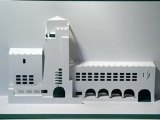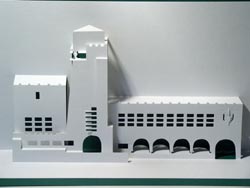
Origamic architecture
Encyclopedia

Architecture
Architecture is both the process and product of planning, designing and construction. Architectural works, in the material form of buildings, are often perceived as cultural and political symbols and as works of art...
, geometric pattern
Pattern
A pattern, from the French patron, is a type of theme of recurring events or objects, sometimes referred to as elements of a set of objects.These elements repeat in a predictable manner...
s, everyday objects, or other images, on various scales, using cut-out and folded paper, usually thin paperboard
Paperboard
Paperboard is a thick paper based material. While there is no rigid differentiation between paper and paperboard, paperboard is generally thicker than paper. According to ISO standards, paperboard is a paper with a basis weight above 224 g/m2, but there are exceptions. Paperboard can be single...
. Visually, these creations are comparable to intricate 'pop-ups', indeed, some works are deliberately engineered to possess 'pop-up'-like properties. However, origamic architecture tends to be cut out of a single sheet of paper, whereas most pop-ups involve two or more. To create the three-dimensional image out of the two-dimensional surface requires skill akin to that of an architect.
Origin
The development of origamic architecture began with Professor Masahiro Chatani’s (then a newly-appointed professor at the Tokyo Institute of Technology) experiments with designing original and unique greeting cards. Japanese culture encourages the giving and receiving of cards for various special occasions and holidays, particularly Japanese New YearJapanese New Year
The is one of the most important annual festivals, with its own unique customs, and has been celebrated for centuries. Due to the importance of the holiday and the preparations required, the preceding days are quite busy, particularly the day before, known as Ōmisoka.The Japanese New Year has been...
, and according to his own account, Professor Chatani personally felt that greeting cards were a significant form of connection and communication between people. He worried that in today’s fast-paced modern world, the emotional connections called up and created by the exchange of greeting cards would become scarce.
In the early 1980s, Professor Chatani began to experiment with cutting and folding paper to make unique and interesting pop-up cards. He used techniques of origami
Origami
is the traditional Japanese art of paper folding, which started in the 17th century AD at the latest and was popularized outside Japan in the mid-1900s. It has since then evolved into a modern art form...
(Japanese paper folding) and kirigami
Kirigami
is a variation of origami that includes cutting of the paper .It is also called "Kirie" . From "Kiru"= to cut, "e"= picture....
(Japanese papercutting
Papercutting
Papercutting is the art of cutting paper designs. The art has evolved uniquely all over the world to adopt to different cultural styles.-History:...
), as well as his experience in architectural design, to create intricate patterns which played with light and shadow. Many of his creations are made of stark white paper which emphasizes the shadowing effects of the cuts and folds. In the preface to one of his books, he called the shadows of the three-dimensional cutouts created a “dreamy scene” that invited the viewer into a “fantasy world."
At first, Professor Chatani simply gave the cards to his friends and family. Over the next nearly thirty years, however, he published over fifty books on origamic architecture, many directed at children. He came to believe that origamic architecture could be a good way to teach architectural design and appreciation of architecture, as well as to inspire interest in mathematics, art, and design in young children.
Professor Chatani also spent a good deal of time, even after his retirement, traveling to exhibit his work. He frequently collaborated on books and exhibits with Keiko Nakazawa and Takaaki Kihara.
Masahiro Chatani
Masahiro Chatani was a Japanese architect (certified, first class) and professor considered to be the creator of origamic architecture. From its development until his death in 2008, he was widely acknowledged to be the world’s foremost origamic architect.Masahiro Chatani was born in Hiroshima, Japan in 1934. He grew up in Tokyo, and graduated from the Tokyo Institute of Technology in 1956. He became an assistant professor at the Tokyo Institute of Technology in 1969 and an associated assistant professor at Washington University in 1977, and was promoted to full professorship at the Tokyo Institute of Technology in 1980. It was around this time that he created what is now known as “origamic architecture.” He became a professor emeritus fifteen years later, and continued to lecture at a number of institutions, including the Japan Architectural College, Hosei University, and the Shizuoka University of Art and Architecture. After his retirement from active professorship, he continued to travel around the world, giving exhibits, demonstrations, and seminars on architectural design and origamic architecture.
Professor Chatani died on November 19, 2008, at the age of 74, from complications from larynx cancer.
Types of Origamic Architecture
There are several different styles of origamic architecture. In one style, a folded paper is cut in such a way that when the paper is opened to form a 90-degree angle, a three-dimensional image can be created, similar to most pop-up books. A second style requires attaching a cut-out form to a base sheet of paper with thread.Takaaki Kihara frequently uses another technique in which the three-dimensional structure is “punched out” of the flat card. Designs created with this technique allow the viewer to see the empty cutouts, which can create interesting shadowing effects. Kihara also points out that this style of origamic architecture is easier to store than the other 180-degree form, as the cut-out three-dimensional forms can be re-flattened with ease.
Less commonly, some designs require opening the paper and folding it completely in the opposite direction, making a 360-degree angle.
Leading Practitioners
Although origamic architecture was developed and first gained popularity in Japan, it is today practiced in countries all over the world.- Keiko Nakazawa (Japan)
- Takaaki Kihara
- Ingrid Siliakus (the Netherlands)
- Maria Garrido (Spain)
External links
- Ingrid Siliakus' website
- Keiko Nakazawa's website
- Maria Garrido's website
- Masahiro Chatani's biography in English
- Masahiro Chatani's website (Japanese only)
- The Origami Resource Center's Origamic Architecture page
- Papyromania
- Takaaki Kihara's website
- Tjeerd Kuipers
- Joyce Aysta's website
- http://www.bianchepieghe.it
- ANN Handicraft
- Yee's Job website
- http://www.lin-artdesign.com/Lin-artdesign

